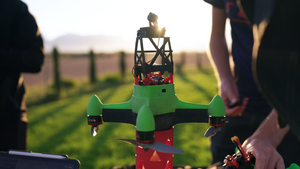Welcome to the first lesson in our series on building your own 5-inch freestyle FPV drone! Before we dive into assembly, let's start by creating a detailed shopping list of the essential components needed for the build.
The Shopping List
1. Frame
The heart of your drone is its frame. Since this guide focuses on a 5-inch freestyle drone, you'll need a frame designed for 5-inch propellers. Ensure it's sturdy and durable to withstand the high speeds and possible crashes.
2. Video System
A critical part of your drone is the video system, which consists of a video transmitter (VTx) and a camera. The system you choose depends on the technology you're already using:
- DJI O3 or DJI Original
- Walksnail
- Analog
- HDZero
This guide provides specific instructions for each video system in later modules, so you'll be well-equipped no matter your setup.
3. Batteries
Selecting the right batteries is crucial. In a later module, we'll cover how to choose between 4S (4-cell) and 6S (6-cell) batteries, depending on your drone's specific power requirements.
4. Motors
Motors are essential for flight performance. The selection will be based on kV rating, size, and power requirements. Rest assured, we'll guide you through this process to find the right fit for your build.
5. Electronic Speed Controller (ESC)
The ESC controls the power supplied to the motors. Selecting the right one involves matching it to your drone's specifications. We'll provide in-depth guidance on this in future lessons.
6. Flight Controller
The flight controller acts as the drone's brain, managing all the inputs and outputs for flight control. Make sure to choose one compatible with your drone's configuration.
7. Radio Receiver
The radio receiver connects your controller to the drone. Whether you use Crossfire, ELRS, Tracer, or Ghost, this guide will walk you through setting it up.
8. Video Antenna
A video antenna ensures a solid video feed, improving range and penetration. While some video systems include antennas, many analog setups require separate antennas for better performance.
9. Propellers
Proper propellers are essential for optimal flight performance. Choose propellers that match your frame size and motor specifications.
10. Other Equipment
Depending on your experience, you might need a charger and power supply. If you're already using a charger for smaller drones like whoops or micros, ensure it's compatible with your new drone's battery requirements.

The Tools List
Building an FPV drone is an intricate task requiring the right tools. Having the correct gear makes the process easier and reduces the likelihood of costly errors. Here’s a comprehensive list of essential tools:
If you just want the essentials in one easy item to buy, I suggest you consider the NewBeeDrone Tool Kit, as it's got all the basics you need to build and repair drones.

Otherwise the list below consists of the full toolkit list you realy need for the FPV hobby.
1. Hex Drivers
- Sizes: A complete set, from 1.5mm to 3mm, is crucial.
- Most Used: 1.5mm for small components, 2mm and 2.5mm for larger ones.
2. Precision Screwdriver
- Necessary for DJI systems, especially the O3 air unit, which uses small Phillips screws.
3. Soldering Iron
- Recommended Model: S100
- Tips: C4 for ESC and battery leads, BC2 for flight controllers, and a fine tip for delicate work.
4. Soldering Accessories
- Cleaning Tools: Solder pig or sponge to keep the iron tip clean.
- Iron Stand: To prevent burning your desk.
- Solder: 60/40 with 2% flux, ideally in a 1mm thickness.
- Solder Wick: Essential for cleaning up excess solder.
- Flux: Rosin flux for smooth soldering.
5. Tweezers
- Handy for holding wires while soldering and avoiding burns.
6. Snips
- Larger snips for thick battery wires and smaller snips for delicate motor wires.
7. Pliers
- Long-nose and regular pliers for various tasks.
8. Electrical Tape
- Useful for insulation and securing wires.
9. Cable Ties
- Ideal for securing wires and mounting antennas or VTxs.
10. Smoke Stopper
- A homemade or store-bought device to protect your electronics from shorts.
11. Blu Tack
- Keeps components steady during soldering.
12. Prop Tool
- Specialized tool for attaching and removing propellers.
13. Additional Tools
- Hook-up Wire: For extending connections.
- Soldering Mat: Protects your desk from heat and organizes parts.
- Cigarette Lighter: For heat-shrink tubing.
- Multimeter: To check for shorts and continuity.
- Magnifying Glass: For precise work.
Having these tools at hand ensures you’re prepared to build your FPV drone efficiently. In the next class, we'll discuss the skills you'll need to master this project.
The Skills
1. Patience
Patience is essential when building FPV drones. It's tempting to rush the process, eager to see the final product take flight. However, haste can lead to errors like solder blobs and incorrect connections, resulting in malfunctioning components that don't work properly and sometimes get damaged. This can be frustrating when you're out on the field, scratching your head over why your drone isn't flying right. Take your time, follow each step carefully, and remember that thoroughness is key to a successful build.
2. Pragmatism
Being pragmatic means approaching the build with a step-by-step mindset. Don't assume you've done everything right just because it seems correct. Instead, systematically check each component and connection, and don't hesitate to go back and verify your work if something doesn't seem right. Pragmatism will save you from going down rabbit holes of unnecessary troubleshooting when the actual problem could be as simple as a mismatched TX/RX connection. Measure twice, cut once, and be meticulous to avoid frustration down the road.
3. Open-mindedness and Self-Critique
An open mind and a willingness to self-critique are vital when building drones. If you always assume you're right, you'll miss errors that can impede your progress. Don't dismiss the possibility of having made a mistake. Question your work and revisit assumptions to uncover errors. Adopting this mindset helps you remain flexible and improves your troubleshooting skills, enabling you to address issues more efficiently.
By cultivating patience, pragmatism, and open-mindedness, you'll develop a solid foundation for building and maintaining FPV drones. These skills will help you approach the process with the right mindset, ensuring fewer mistakes and a more enjoyable journey toward your first flight.






